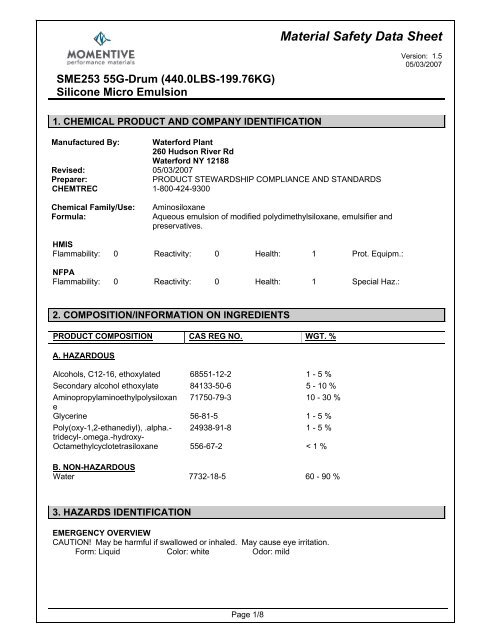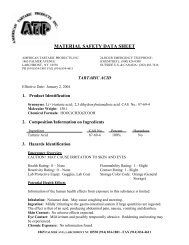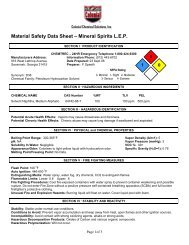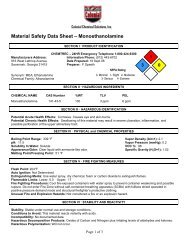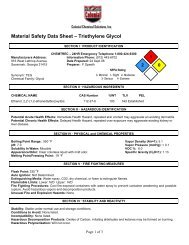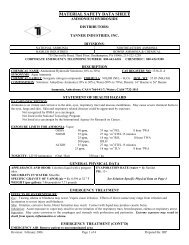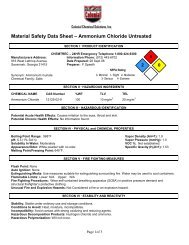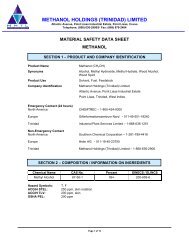MSDS - Colonial Chemical Solutions
MSDS - Colonial Chemical Solutions
MSDS - Colonial Chemical Solutions
Create successful ePaper yourself
Turn your PDF publications into a flip-book with our unique Google optimized e-Paper software.
Material Safety Data Sheet<br />
SME253 55G-Drum (440.0LBS-199.76KG)<br />
Silicone Micro Emulsion<br />
Version: 1.5<br />
05/03/2007<br />
1. CHEMICAL PRODUCT AND COMPANY IDENTIFICATION<br />
Manufactured By: Waterford Plant<br />
260 Hudson River Rd<br />
Waterford NY 12188<br />
Revised: 05/03/2007<br />
Preparer:<br />
PRODUCT STEWARDSHIP COMPLIANCE AND STANDARDS<br />
CHEMTREC 1-800-424-9300<br />
<strong>Chemical</strong> Family/Use:<br />
Formula:<br />
Aminosiloxane<br />
Aqueous emulsion of modified polydimethylsiloxane, emulsifier and<br />
preservatives.<br />
HMIS<br />
Flammability: 0 Reactivity: 0 Health: 1 Prot. Equipm.:<br />
NFPA<br />
Flammability: 0 Reactivity: 0 Health: 1 Special Haz.:<br />
2. COMPOSITION/INFORMATION ON INGREDIENTS<br />
PRODUCT COMPOSITION CAS REG NO. WGT. %<br />
A. HAZARDOUS<br />
Alcohols, C12-16, ethoxylated 68551-12-2 1 - 5 %<br />
Secondary alcohol ethoxylate 84133-50-6 5 - 10 %<br />
Aminopropylaminoethylpolysiloxan 71750-79-3 10 - 30 %<br />
e<br />
Glycerine 56-81-5 1 - 5 %<br />
Poly(oxy-1,2-ethanediyl), .alpha.- 24938-91-8 1 - 5 %<br />
tridecyl-.omega.-hydroxy-<br />
Octamethylcyclotetrasiloxane 556-67-2 < 1 %<br />
B. NON-HAZARDOUS<br />
Water 7732-18-5 60 - 90 %<br />
3. HAZARDS IDENTIFICATION<br />
EMERGENCY OVERVIEW<br />
CAUTION! May be harmful if swallowed or inhaled. May cause eye irritation.<br />
Form: Liquid Color: white Odor: mild<br />
Page 1/8
Material Safety Data Sheet<br />
SME253 55G-Drum (440.0LBS-199.76KG)<br />
Silicone Micro Emulsion<br />
Version: 1.5<br />
05/03/2007<br />
POTENTIAL HEALTH EFFECTS<br />
INGESTION<br />
May be harmful if swallowed. May cause tissue damage.<br />
SKIN<br />
No adverse effects are expected under normal conditions of use.<br />
INHALATION<br />
May be harmful if inhaled. Inhalation of mist may cause damage to nasal and respiratory passages.<br />
EYES<br />
May cause mild eye irritation.<br />
MEDICAL CONDITIONS AGGRAVATED<br />
None known.<br />
SUBCHRONIC (TARGET ORGAN )<br />
None known.<br />
CHRONIC EFFECTS / CARCINOGENICITY<br />
This product or one of its ingredients present at 0.1% or more is NOT listed as a carcinogen or<br />
suspected carcinogen by NTP, IARC, or OSHA.<br />
ROUTES OF EXPOSURE<br />
Inhalation; Ingestion; Eyes<br />
OTHER<br />
Contains octamethylcyclotetrasiloxane which may cause reproductive effects based on animal<br />
data.<br />
4. FIRST AID MEASURES<br />
INGESTION<br />
Do not induce vomiting. If victim is conscious, give 1-3 glasses of water to drink. Never give<br />
anything by mouth to an unconscious person. Get medical attention if irritation persists.<br />
SKIN<br />
Remove and wash contaminated clothing before re-use. Wash off with soap and water. Get<br />
medical attention if irritation persists.<br />
INHALATION<br />
Move person to fresh air.<br />
EYES<br />
In case of contact, or suspected contact, immediately flush eyes with plenty of water for at least<br />
15 minutes and get medical attention immediately after flushing.<br />
Page 2/8
Material Safety Data Sheet<br />
SME253 55G-Drum (440.0LBS-199.76KG)<br />
Silicone Micro Emulsion<br />
Version: 1.5<br />
05/03/2007<br />
NOTE TO PHYSICIAN<br />
Treatment is symptomatic and supportive.<br />
5. FIRE-FIGHTING MEASURES<br />
FLASH POINT:<br />
METHOD:<br />
IGNITION TEMPERATURE:<br />
FLAMMABLE LIMITS IN AIR - LOWER (%):<br />
FLAMMABLE LIMITS IN AIR - UPPER (%):<br />
SENSITIVITY TO MECHANICAL IMPACT:<br />
Not applicable Aqueous system<br />
Not applicable<br />
Not applicable<br />
No<br />
SENSITIVITY TO STATIC DISCHARGE<br />
Sensitivity to static discharge is not expected.<br />
EXTINGUISHING MEDIA<br />
All standard extinguishing agents are suitable.<br />
SPECIAL FIRE FIGHTING PROCEDURES<br />
Firefighters must wear NIOSH/MSHA approved positive pressure self-contained breathing<br />
apparatus with full face mask and full protective clothing.<br />
6. ACCIDENTAL RELEASE MEASURES<br />
ACTION TO BE TAKEN IF MATERIAL IS RELEASED OR SPILLED<br />
Wipe, scrape or soak up in an inert material and put in a container for disposal. Wear proper protective<br />
equipment as specified in the protective equipment section. Warn other workers of spill.<br />
7. HANDLING AND STORAGE<br />
STORAGE<br />
Store at room temperature in the original container. Keep container closed. Recommended Storage<br />
Between 35F (2C) and 80F(26 C).<br />
PRECAUTIONS TO BE TAKEN IN HANDLING AND STORAGE<br />
Avoid contact with skin, eyes and clothing. Use only in well-ventilated areas. Do not freeze. Stir well<br />
before using. Keep away from children. Attention: Not for injection into humans. May generate<br />
formaldehyde at temperatures greater than 150 C (300 F). See Section 10 of <strong>MSDS</strong> for details.<br />
Page 3/8
Material Safety Data Sheet<br />
SME253 55G-Drum (440.0LBS-199.76KG)<br />
Silicone Micro Emulsion<br />
Version: 1.5<br />
05/03/2007<br />
8. EXPOSURE CONTROLS / PERSONAL PROTECTION<br />
ENGINEERING CONTROLS<br />
Eyewash stations; Showers; Exhaust ventilation; Ventilation and other forms of engineering controls<br />
are preferred for controlling exposures. Respiratory protection may be needed for non-routine or<br />
emergency situations.<br />
RESPIRATORY PROTECTION<br />
If exposure limits are exceeded or respiratory irritation is experienced, NIOSH/MSHA approved<br />
respiratory protection should be worn. Supplied air respirators may be required for non-routine or<br />
emergency situations. Respiratory protection must be provided in accordance with OSHA regulations<br />
(see 29 CFR 1910.134).<br />
PROTECTIVE GLOVES<br />
Impermeable or chemical resistant gloves.<br />
EYE AND FACE PROTECTION<br />
Safety glasses with side-shields<br />
OTHER PROTECTIVE EQUIPMENT<br />
Wear suitable protective clothing and eye/face protection.<br />
Exposure Guidelines<br />
Component CAS RN Source Value<br />
Glycerine 56-81-5 ACGIH, TWA Mist. 10 mg/m3<br />
Glycerine 56-81-5 OSHA Z1, PEL Respirable fraction. 5 mg/m3<br />
Glycerine 56-81-5 OSHA Z1, PEL Total dust. 15 mg/m3<br />
Absence of values indicates none found<br />
PEL - OSHA Permissible Exposure Limit; TLV - ACGIH Threshold Limit Value; TWA - Time Weighted Average<br />
OSHA revoked the Final Rule Limits of January 19, 1989 in response to the 11th Circuit Court of Appeals decision (AFL-CIO v. OSHA)<br />
effective June 30, 1993. See 29 CFR 1910.1000 (58 FR 35338).<br />
9. PHYSICAL AND CHEMICAL PROPERTIES<br />
BOILING POINT - C & F: ca.100 °C; 212 °F<br />
VAPOR PRESSURE (20 C) (MM HG):<br />
No data available<br />
VAPOR DENSITY (AIR=1):<br />
No data available<br />
FREEZING POINT:<br />
No data available<br />
MELTING POINT:<br />
No data available<br />
PHYSICAL STATE:<br />
Liquid<br />
ODOR:<br />
mild<br />
COLOR:<br />
white<br />
EVAPORATION RATE (BUTYL ACETATE=1): Unknown<br />
SPECIFIC GRAVITY (WATER=1): ca. 1.0<br />
Page 4/8
Material Safety Data Sheet<br />
SME253 55G-Drum (440.0LBS-199.76KG)<br />
Silicone Micro Emulsion<br />
Version: 1.5<br />
05/03/2007<br />
DENSITY:<br />
ca. 1.0 g/cm3<br />
ACID / ALKALINITY (MEQ/G):<br />
No data available<br />
pH: ca. 6.3<br />
VOLATILE ORGANIC CONTENT (VOL):<br />
4 %(m)<br />
SOLUBILITY IN WATER (20 C):<br />
Insoluble<br />
SOLUBILITY IN ORGANIC SOLVENT (STATE No data available<br />
SOLVENT):<br />
VOC EXCL. H2O & EXEMPTS (G/L):<br />
No data available<br />
10. STABILITY AND REACTIVITY<br />
STABILITY<br />
Stable<br />
HAZARDOUS POLYMERIZATION<br />
Will not occur<br />
HAZARDOUS THERMAL DECOMPOSITION / COMBUSTION PRODUCTS<br />
After evaporation of water, residue can burn to produce:; Carbon dioxide (CO2); Carbon monoxide;<br />
Silicon dioxide.; formaldehyde; This product contains components which can generate formaldehyde<br />
at approximately 300 F (150 C) and above in atmospheres which contain oxygen. Formaldehyde is a<br />
skin and respiratory sensitizer, eye and throat irritant, acute toxicant, and potential cancer hazard. An<br />
<strong>MSDS</strong> for formaldehyde is available from Momentive Performance Materials, Inc.<br />
INCOMPATIBILITY (MATERIALS TO AVOID)<br />
None known.<br />
CONDITIONS TO AVOID<br />
Do not freeze.<br />
11. TOXICOLOGICAL INFORMATION<br />
ACUTE ORAL<br />
LD50; Species: rat; > 5,000 mg/kg;<br />
ACUTE DERMAL<br />
Remarks: No data available<br />
ACUTE INHALATION<br />
Remarks: No data available<br />
OTHER<br />
Animal studies have shown that inhalation of aminosilicones or aminosilicone emulsions may be<br />
hazardous. A NIOSH approved respirator should be worn if processing of this material is likely to form<br />
an aerosol or mist., Octamethylcyclotetrasiloxane Ingestion: Rodents given large doses via oral<br />
gavage of octamethylcyclotetrasiloxane (1600 mg/kg day, 14 days) developed increased liver weights<br />
Page 5/8
Material Safety Data Sheet<br />
SME253 55G-Drum (440.0LBS-199.76KG)<br />
Silicone Micro Emulsion<br />
Version: 1.5<br />
05/03/2007<br />
relative to unexposed control animals due to hepatocellular hyperplasia (increased number of liver<br />
cells which appear normal) as well as hypertrophy (increased cell size). Inhalation: In inhalation<br />
studies, laboratory rodents exposed to octamethylcyclotetrasiloxane (300 ppm five days week, 90<br />
days) developed increased liver weights in female animals relative to unexposed control animals.<br />
When the exposure was stopped, liver weights returned to normal. Microscopic examination of the<br />
liver cells did not show any evidence of pathology. Inhalation studies utililizing laboratory rabbits and<br />
guinea pigs showed no effects on liver weights. Inhalation exposures typical of industrial usage (5-10<br />
ppm) showed no toxic effects in rodents. Range finding reproductive studies were conducted (whole<br />
body inhalation, 70 days prior to mating, through mating, gestation and lactation) with<br />
octamethylcyclotetrasiloxane (D4). Rats were exposed to 70 and 700 ppm. In the 700 ppm group,<br />
there was a statistically significant reduction in mean litter size and in implantation sites. No D4<br />
related clinical signs were observed in the pups and no exposure related pathological findings were<br />
found. Interim results from a two generation reproductive study in rats exposed to 500 and 700 ppm<br />
D4 (whole body inhalation, 70 days prior to mating, through mating, gestation and lactation) resulted in<br />
a statistically significant decrease in live mean litter size as well as extended periods of off-spring<br />
delivery (dystocia). These results were not observed at the 70 and 300 ppm dosing levels. Preliminary<br />
results from an ongoing 24-month combined chronic/oncogenicity study in rats exposed to 10, 30, 150,<br />
or 700 ppm D4 showed test-article related effects in the kidney (male and female) and uterus of rats<br />
exposed for 12 to 24 months. These effects include increased kidney weight and severity of chronic<br />
nephropathy, increased uterine weight, increased incidence of endometrial cell hyperplasia, and an<br />
increased incidence of endometrial adenomas. All of these effects are limited to the 700 ppm<br />
exposure group. The relevance of these data to humans is unclear. Further studies are ongoing. In<br />
developmental toxicity studies, rats and rabbits were exposed to octamethylcyclotetrasiloxane at<br />
concentrations up to 700 ppm and 500 ppm respectively. No teratogenic effects (birth defects) were<br />
observed in either study.<br />
SENSITIZATION<br />
Test Type: Magnusson-Kligmann; Result: Did not cause sensitization on laboratory animals.<br />
SKIN IRRITATION<br />
Species: rabbit; Result: No skin irritation<br />
EYE IRRITATION<br />
Species: rabbit ; Result: No eye irritation<br />
MUTAGENICITY<br />
Unknown<br />
12. ECOLOGICAL INFORMATION<br />
ECOTOXICOLOGY<br />
No data available<br />
CHEMICAL FATE<br />
No data available<br />
DISTRIBUTION<br />
No data available<br />
Page 6/8
Material Safety Data Sheet<br />
SME253 55G-Drum (440.0LBS-199.76KG)<br />
Silicone Micro Emulsion<br />
Version: 1.5<br />
05/03/2007<br />
13. DISPOSAL CONSIDERATIONS<br />
DISPOSAL METHOD<br />
Disposal should be made in accordance with federal, state and local regulations.<br />
14. TRANSPORT INFORMATION<br />
Further Information:<br />
This product is not regarded as dangerous goods according to the<br />
national and international regulations on the transport of dangerous<br />
goods.<br />
15. REGULATORY INFORMATION<br />
Inventories<br />
EU list of existing chemical<br />
substances<br />
Canada DSL Inventory<br />
Canada NDSL Inventory<br />
Japan Inventory of Existing &<br />
New <strong>Chemical</strong> Substances<br />
(ENCS)<br />
Korea Existing <strong>Chemical</strong>s<br />
Inventory (KECI)<br />
China Inventory of Existing<br />
<strong>Chemical</strong> Substances<br />
Australia Inventory of <strong>Chemical</strong><br />
Substances (AICS)<br />
Philippines Inventory of<br />
<strong>Chemical</strong>s and <strong>Chemical</strong><br />
Substances (PICCS)<br />
TSCA list<br />
y (Positive listing)<br />
y (Positive listing)<br />
n (Negative listing)<br />
y (Positive listing)<br />
y (Positive listing)<br />
y (Positive listing)<br />
y (Positive listing)<br />
y (Positive listing)<br />
y (Positive listing)<br />
For inventories that are marked as quantity restricted or special cases, please contact GE.<br />
US Regulatory Information<br />
CERCLA<br />
PRODUCT COMPOSITION <strong>Chemical</strong> CERCLA Reportable Quantity<br />
CLEAN AIR ACT<br />
CLEAN WATER ACT<br />
Page 7/8
Material Safety Data Sheet<br />
SME253 55G-Drum (440.0LBS-199.76KG)<br />
Silicone Micro Emulsion<br />
Version: 1.5<br />
05/03/2007<br />
SARA SECTION 302<br />
SARA (311,312) HAZARD CLASS<br />
Acute Health Hazard<br />
SARA (313) CHEMICALS<br />
Canadian Regulatory Information<br />
WHMIS HAZARD CLASS<br />
D2A VERY TOXIC MATERIALS, D2B TOXIC MATERIALS<br />
Other<br />
SCHDLE B/HTSUS:<br />
ECCN:<br />
3910.00.00.00 Silicones in primary form<br />
EAR99<br />
CALIFORNIA PROPOSITION 65<br />
This product does not contain any chemicals known to State of California to cause cancer, birth, or<br />
any other reproductive defects.<br />
16. OTHER INFORMATION<br />
OTHER<br />
These data are offered in good faith as typical values and not as product specifications. No warranty,<br />
either expressed or implied, is made. The recommended industrial hygiene and safe handling<br />
procedures are believed to be generally applicable. However, each user should review these<br />
recommendations in the specific context of the intended use and determine whether they are<br />
appropriate., C = ceiling limit NEGL = negligible EST = estimated NF = none found<br />
NA = not applicable UNKN = unknown NE = none established REC = recommended ND =<br />
none determined V = recommended by vendor SKN = skin TS = trade secret R =<br />
recommended MST = mist NT = not tested STEL = short term exposure limit ppm =<br />
parts per million ppb = parts per billion By-product= reaction by-product, TSCA inventory status<br />
not required under 40 CFR part 720.30(h-2).<br />
Page 8/8


